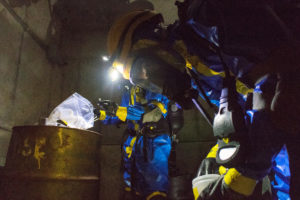Sam Campbell
FORT LEONARD WOOD, Mo. (Dec. 9, 2019) – From Nov. 20 through 26, Chemical, Biological, Radiological and Nuclear specialist Soldiers investigated simulated chemical weapons operations and crawled through dark, narrow underground tunnels in search of the chemicals as part of the Technical Escort Course’s final exam — the Situational Training Exercise, or STX.
The exercise began when the students received a “tip” that hostile forces were making weapons in a complex of buildings behind the Lt. Joseph Terry CBRN Responder Training Facility.
The students went through the structures, room by room, taking note of what they found and extracting munitions to take back to a laboratory for testing.
Later in the exercise, CBRN specialists equipped with HAZMAT suits, gas masks and air tanks navigated the almost pitch-black subterranean labyrinth uncertain of what they would find, but ready to test for anything.
Their ultimate goal? Positive confirmation of any chemical agents found, and the subsequent briefing of their situational “area commander,” Chuck Dashiell, HAZMAT/Dismounted Reconnaissance Department chief, who oversees the course.
Spc. Arturo Montero and Sgt. Trod Williams, TEC students, followed their initial entry team and discovered a cache of chemicals.
“What they wanted to do is go down there and find at least two different ways where they’re getting that presumptive analysis of what was actually happening down there,” said Staff Sgt. Brian Reigle, course instructor.
In addition to their devices’ readings, Reigle said the Soldiers are taught to look for ingredients that could potentially be combined to form a hazardous compound or weapon.
The substance Montero and Williams found was a non-harmful stimulant that still produces a desired effect on hazard-detection equipment.
“We use (it) because the detectors pick that up,” Reigle said. “They get a false positive off of that, so it actually makes it react so we don’t have to just give them a reading. They’re actually getting real-time readings from the piece of equipment.”
Detectors sounding off at irregular intervals added to the already-high stress levels as the team monitored the remaining air levels in their tanks. Nothing was more challenging than low crawling, Montero said.
“You get down low,'” he said. “You’re carrying your equipment, you got your light, and (you’re) trying to make sure your suit doesn’t scrape, because if you get a tear, then you’re compromised.”
Williams said nothing about the exercise made him panic, but that he was happy to have Montero working alongside him.
“He kept it cool and calm,” he said. “After a while, you just think about everything from when you first left to ‘I’ve got to remember to do this and everything,’ and he just caught me and (said) ‘All right, here’s what you need to do.'”
Course instructors said STX is a culminating event, meaning it requires Soldiers to put together lessons learned since the beginning of the course four weeks ago.
“It’s all of their skills put into one mission,” said Staff Sgt. Ryan Fowler, course instructor.
Nov. 27, one day after STX and one day prior to Thanksgiving, students graduated the course and returned to their units, where leaders will be able to see personalized notes taken by instructors on their individual Soldiers.
“Throughout the entire class, we’re always taking notes on every single student,” Fowler said. “It’s like, ‘this guy is really good at hands-on stuff. He excelled in the STX lanes in this and this position.’ We’ll annotate that so that way whenever they go to their new unit, that’s just an extra thing to validate them as a Soldier and as a tech escort member.”
He said this is important so those CBRN Soldiers’ superiors can better understand their skills in continuing education.
“We don’t write cookie-cutter ‘everybody-did-good’ (reviews),” he added. “We take a lot of pride in making sure that all the students have a fair evaluation of what they’ve done and how they’ve done it.”
Montero and Williams said they enjoyed the training and now feel more confident in their ability to respond to situations like this in the future.
“I learned a lot of stuff,” Williams said. “I thought it was great. With the short amount of time I got to work with everybody, I like the cohesion that we all built.”






-30-
About Fort Leonard Wood
Fort Leonard Wood is a thriving and prosperous installation that has evolved from a small basic training post more than 75 years ago to a premier Army Center of Excellence that trains more than 80,000 military and civilians each year.
Fort Leonard Wood is home to the U.S Army Maneuver Support Center of Excellence and three U.S. Army schools: the U.S. Army Engineer School; U.S. Army Chemical, Biological, Radiological and Nuclear School; and the U.S. Army Military Police School. In addition to training engineer, CBRN and military police specialties for the Army, Fort Leonard Wood also provides gender-integrated in-processing and Basic Combat Training for new Soldiers.
Fort Leonard Wood also hosts and trains with the largest Marine Corps Detachment and Air Force Squadron on any Army installation as well as a large Navy construction detachment.
More information about Fort Leonard Wood is at: https://home.army.mil/wood/index.php/about/mission
